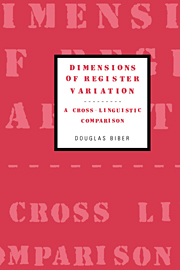Book contents
- Frontmatter
- Contents
- List of figures
- List of tables
- Acknowledgments
- List of abbreviations
- 1 Introduction
- 2 The comprehensive analysis of register variation
- 3 Sociocultural description of the four language situations
- 4 The linguistic bases of cross-linguistic register comparisons: a detailed quantitative comparison of English and Somali registers
- 5 Methodology
- 6 Multi-Dimensional analyses of the four languages
- 7 Cross-linguistic patterns of register variation: synchronic similarities and differences
- 8 Cross-linguistic patterns of register variation: diachronic similarities and differences
- 9 Registers and text types in English and Somali
- 10 Towards cross-linguistic universals of register variation
- Appendix I Grammatical description of linguistic features in Korean. Yong-Jin Kim
- Appendix II Grammatical description of linguistic features in Somali. With Mohamed Hared
- Notes
- References
- Index
9 - Registers and text types in English and Somali
Published online by Cambridge University Press: 07 September 2009
- Frontmatter
- Contents
- List of figures
- List of tables
- Acknowledgments
- List of abbreviations
- 1 Introduction
- 2 The comprehensive analysis of register variation
- 3 Sociocultural description of the four language situations
- 4 The linguistic bases of cross-linguistic register comparisons: a detailed quantitative comparison of English and Somali registers
- 5 Methodology
- 6 Multi-Dimensional analyses of the four languages
- 7 Cross-linguistic patterns of register variation: synchronic similarities and differences
- 8 Cross-linguistic patterns of register variation: diachronic similarities and differences
- 9 Registers and text types in English and Somali
- 10 Towards cross-linguistic universals of register variation
- Appendix I Grammatical description of linguistic features in Korean. Yong-Jin Kim
- Appendix II Grammatical description of linguistic features in Somali. With Mohamed Hared
- Notes
- References
- Index
Summary
Internal variation among texts within registers
The preceding chapters have shown that registers can be described and compared with respect to their linguistic characteristics, from both synchronic and diachronic perspectives. However, registers are identified and defined in situational rather than in linguistic terms. That is, even though register distinctions have strong linguistic correlates, they are defined on the basis of situational characteristics such as the relations among participants, the production circumstances, and the major purposes and goals of communication (see Ferguson 1983; Biber 1994).
Since registers have a primary situational basis, they are not equally well defined in their linguistic characteristics: there are considerable linguistic differences among texts within some registers, while other registers have quite focused norms with relatively small differences among texts. As discussed in section 5.7.3, a wide range of internal variation does not invalidate a register category; rather, this internal range of variation is simply an important descriptive fact about the register. For this reason, a complete quantitative linguistic description of a register must include measures of the variability among texts within the register (e.g., standard deviation or range) as well as measures of the central tendency (the mean).
Internal variation within English registers
Table 9.1 presents descriptive statistics for thirteen English registers, including both the mean and the standard deviation. The analyses in chapter 6 show that the mean dimension scores are important and statistically significant predictors of the differences among registers.
Information
- Type
- Chapter
- Information
- Dimensions of Register VariationA Cross-Linguistic Comparison, pp. 314 - 358Publisher: Cambridge University PressPrint publication year: 1995
